Artillery in Canada (9) Nova Scotia: Halifax, Royal Artillery Park
Royal Artillery Park, Halifax
The aim of this website is to locate, identify and document every historical piece of artillery preserved in Canada. Many contributors have assisted in the hunt for these guns to provide and update the data found on these web pages. Photos are by the author unless otherwise credited. Any errors found here are by the author, and any additions, corrections or amendments to this list of Guns and Artillery in Canada would be most welcome and may be e-mailed to the author at [email protected].
For all official data concerning the Royal Regiment of Canadian Artillery, please click on the link to their website:
Royal Regiment of Canadian Artillery Website
Note: Back in the day, artillery in Canada was referred to by its radio call sign "Sheldrake". It is now referred to by its "Golf" call sign. (Acorn sends)
The web page for Nova Scotia has become too big for all the guns to be listed on one page, therefore the guns on display within Annapolis Royal including Fort Anne, the City of Halifax including York Redoubt, the Fort George Citadel, the Maritime Command Museum and Royal Artillery Park etc., are listed on separate pages for Nova Scotia.
Halifax, Royal Artillery Park


Queen Anne of Great Britain (1665-1714, r. 1702-1714), with her monogram. (Wikipedia Photo)

.webp)
(Author Photos)
Although the rose and crown cypher has traditionally been interpreted as representing Queen Anne (1702-1714). It was used not only by the rest of the Stuarts, but confusingly by King George I for iron guns. King George II guns are recognized by the GR2. This cypher is on the barrel of a cast Iron 24-pounder smoothbore muzzleloading cannon located in front of the entrance to the Officer’s Mess. (It is a fairly rare cypher on cannon in Canada)
British bronze guns had monograms for all the different kings and queens. But most of the cast-iron guns of this period just had a rose and crown, right up to the 1720s. Some Charles and some William and Mary guns did have a simple monogram, but most British iron guns for government use before 1726 all used the rose and crown. (Ruth Rhynas Brown)

(Author Photo)
Queen's Arrow mark on the Cast Iron 24-pounder SBML.
.webp)
.webp)
.webp)
(Author Photos, 16 July 2025)


(Author Photos)
Cast Iron 24-pounder Smoothbore Muzzleloading Gun weight 47---- (>5000 lbs), left and right trunnions corroded, 78 to the left of the Queen Anne cypher (1701-1714), mounted on iron posts. This is Naval gun from a ship of the line. Located in front of the entrance to the Officer’s Mess.
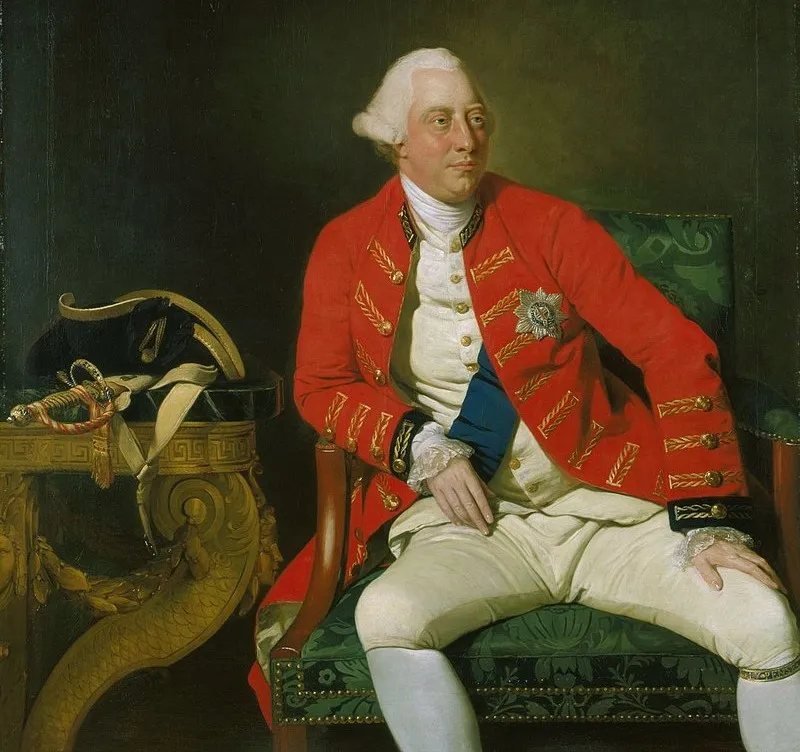
(Royal Collection, RCIN Photo)
A three quarter length figure of King George III seated in a General Officer's coat with the ribbons and star of the Garter, wearing the Garter around his leg; his hat and sword resting on a nearby table. Finished in 1771 it portrays the king at age 33, with a steady serious gaze, a ruddy healthy face, and a calm assured demeanor. King George III of England, aged 33 years, oil painting on canvas by Johann Zoffany, circa 1771.

King George III and his royal cypher.
.webp)
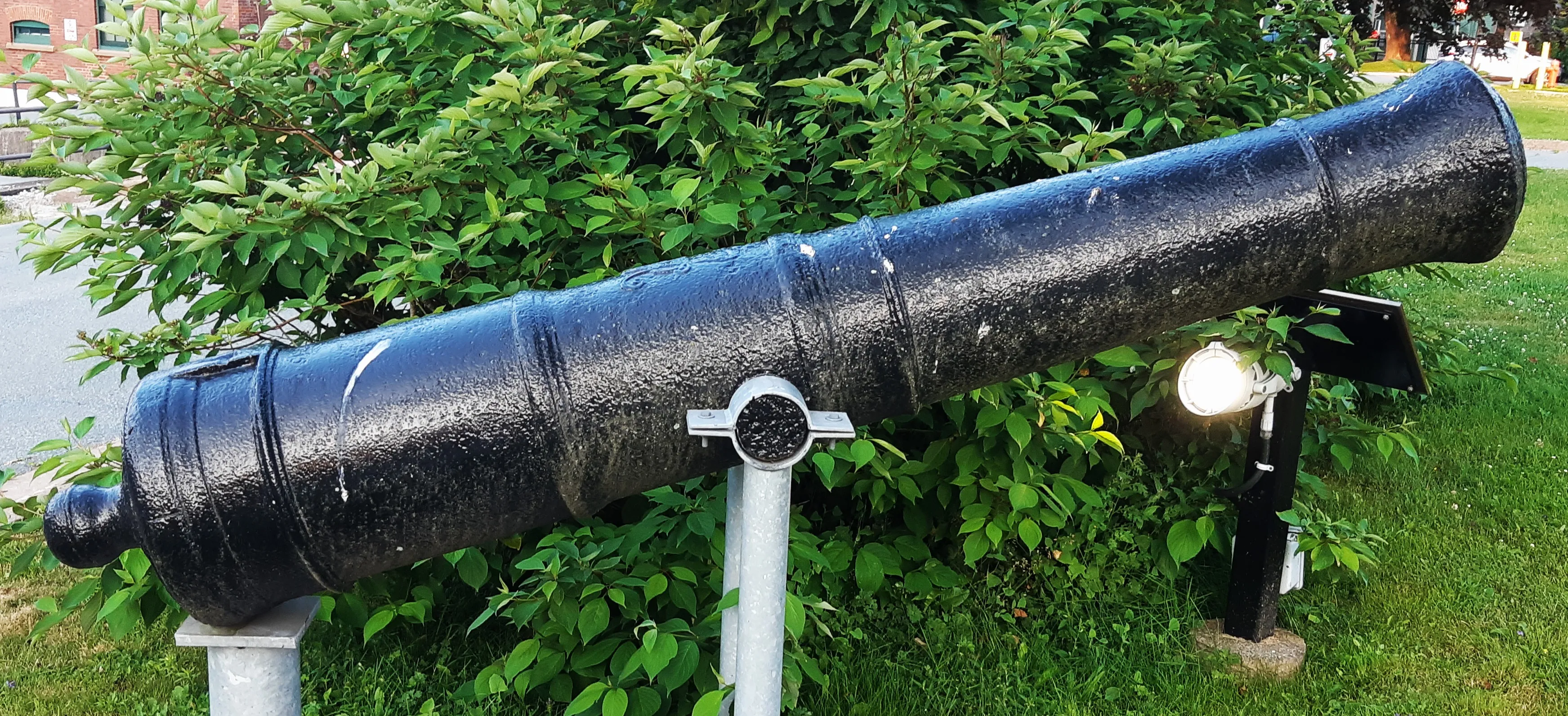
.webp)
.webp)
(Author Photos, 16 July 2025)


(Author Photos)
Cast Iron 12-pounder Smoothbore Muzzleloading Gun, weight 29-2-15 (3,317 lbs), left and right trunnions corroded, King George III cypher, mounted on iron posts, ca. 1764.

Left trunnion.

Right trunnion.

King George III cypher.

Weight 28-3-1 (3,221 lbs).


(Author Photos)
Cast Iron 12-pounder Smoothbore Muzzleloading Gun, weight 28-3-1 (3,221 lbs), left and right trunnions corroded, King George III cypher, mounted on iron posts, ca. 1764. No. 2.

(Ducal Museum Gotha Photo)
Queen Victoria, painted by Franz Xaver, Winterhalter, 1843.

Queen Victoria reigned from 2 June 1837 to 22 Jan 1901, portrait at her Coronation, 1838, and her royal cypher. (Wikipedia Photo)




(Author Photos)
7-pounder Steel Mk. IV 200 lb Rifled Muzzleloader Gun, weight 1-3-6 (202 lbs), (RGF No. 397, IV, 1878) on the right trunnion, Queen Victoria cypher, mounted on a iron carriage with a bronze plate stamped 1874, Royal Carriage Department (R.C.D.) I, W (arrow) D, Reg. No. 65, Wt 137. (No. 1 of 3), in front of the Officer's Mess. (Now in storage)



(Author Photos)
7-pounder Steel Mk. IV 200 lb Rifled Muzzleloader Gun, weight 1-3-5 (201 lbs), (RGF No. 251, IV, 1877) on the right trunnion, Queen Victoria cypher, mounted on an iron carriage, 1874, RCD I, WD, Reg. No. 65, (No. 2 of 3), standing in front of the Officer’s Mess. Now in storage.



(Author Photos)
7-pounder Steel Mk. IV 200 lb Rifled Muzzleloader Gun, weight 1-3-7 (203 lbs), (RGF No. 418, IV, 1878) on right trunnion, Queen Victoria Cypher, mounted on an iron carriage, (No. 3 of 3), standing in front of the Officer’s Mess. These three guns were generally classified as Mountain or boat guns. Now in storage.


(Photos courtesy of the Fleet Diving Unit)
.webp)
.webp)
(Author Photos, 16 July 2025)



(Author Photos)
The RML 9-inch guns of the 1860s were used as primary armament on smaller British ironclad battleships and secondary armament on larger battleships, and also ashore for coast defence. The rifling was the Woolwich pattern (based on an Armstrong design) with a relatively small number of broad, rounded shallow grooves : there were 6 grooves, increasing from 0 to 1 turn in 45 calibres (i.e. 405 in (1,030 cm)).
The gun in RA Park is a cast iron 9-inch 12-ton Mk. I Muzzleloading Rifle with a Millar pattern breeching ring, weight 12-13-1-0 (28,364 lbs), left and right trunnions corroded, with Firths Steel 1899 on the muzzle. This gun is one of the four recovered from a trench in front of the Halifax Armoury in 2011. The gun is mounted on iron posts. Weight (12 X 2,240 = 26,880 lbs) + (13 X 112 = 1,456 lbs) + (1 X 28 = 28 lbs) = 28,364 lbs.
.webp)
.webp)
(Author Photos, 16 July 2025)




Left trunnion.

Right trunnion.

Rifled Muzzle, Firth Steel 1820.

Royal Carriage Department (R.C.D.), 11872 No. 60, I.

Weight 5-3-26 (670 lbs). (Author Photos)
9-pounder 6-cwt (SS) Muzzleloading Rifle, weight 5-3-26 (670 lbs), (RGF No. 399, II, 1875) on the left trunnion, blank on the right trunnion, Firths Steel 4320 on the muzzle, Queen Victoria cypher on the barrel. The gun is mounted on an iron carriage, WD, Royal Carriage Department (R.C.D.) 11872, No. 60, I, with wood 12-pounder wheels, ca. 1874-1895. This gun stands facing the Halifax Citadel. Another 9-pounder 6-cwt Muzzleloading Rifle preserved in Canada, RGF No. unknown, is on display in the Royal Canadian Artillery Museum, CFB Shilo, Manitoba and a third is in display at the war memorial in Shelburne, Nova Scotia, RGF No. unknown. These 9-pounder 6-cwt guns were probably left behind when the British left Halifax in 1905. All other 9-pounder Muzzleloading Rifles in Canada are 8-cwt.

(Library and Archives Canada Photo, MIKAN No. 3397505)
12-pounder 6-cwt Breechloading Mk. IV Gun, Salisbury Plain, England, 1914.

(Library and Archives Canada Photo, MIKAN No. 4234796)
12-pounder 6-cwt Breechloading Mk. IV Gun, RCHA drill.
.webp)
.webp)
.webp)
.webp)
(Author Photos)




Left trunnion.

Right trunnion.

(Author Photos)
Royal Carriage Department (R.C.D.), 1900, Reg. No. C4594, No, 27.
12-pounder 6-cwt Breechloading Mk. I Gun, weight 6-0-16 (688 lbs), (12PR, 6Cwt, 123), on the left trunnion, (RGF, 1897, King's Arrow) on the right trunnion, Queen Victoria cypher on the barrel, mounted on a wheeled iron carriage, R.C.D. 1900, Reg. No. C.4594, No. 27. This gun stands facing the Halifax Citadel. (Two of these guns are recorded in Halifax in 1933: Reg. No. 125, RGF unknown, and Reg. No. 176, RGF 97).


(British Government Photos)
5-inch Breech-loading Mk. I Howitzer in use during the Boer War.




Breech.

Left trunnion.

Right trunnion.

(Author Photos)
Weight 8-3-8 (988 lbs).
5-inch Breech-loading Mk. I Howitzer, weight 8-3-8 (988 lbs) on the barrel. The breech is stamped (BL 5" How, No. 65, RGF 1899). The right trunnion appears to be a separate part of the gun carriage assembly, not the gun, and is stamped Royal Carriage Department (R.C.D.) 1800, Reg. No. C.4597). This was the first British gun to use Recoil Absorbers. The gun is mounted on an iron Mk. I carriage with wooden wheels. The iron trail is stamped with a different part number, (I, RCD 1900, Reg. No. C.4594, No. 27). This gun stands facing the Halifax Citadel.
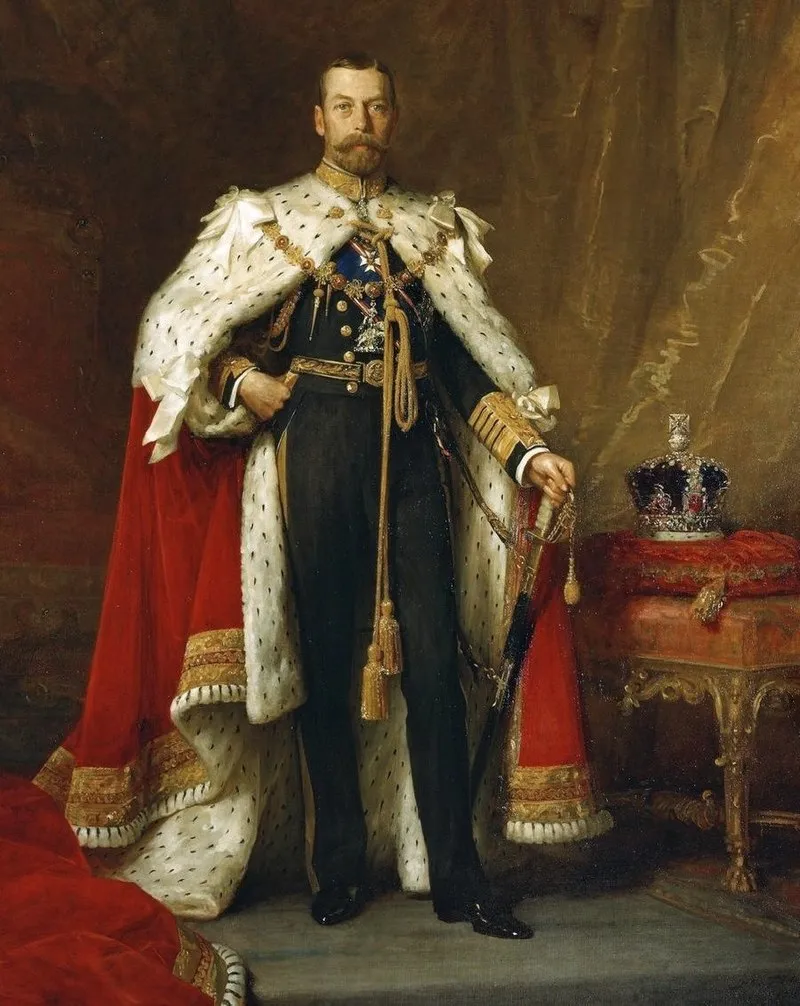
(Royal Collection, United Kingdom Photo)
King George V in coronation robes (c1911). Oil on canvas, 279.8 x 183.3 cm.

Cypher of King George V (George Frederick Ernest Albert; 3 June 1865 – 20 January 1936), ruled from 6 May 1910 until his death in 1936.

(Library and Archives Canada Photo, MIKAN No. 3336980)
18-pounder QF Mk. I Field Gun, Camp Valcartier, ca. 1914.

(City of Vancouver Archives Photo, AM1535-: CVA 99-597)
18-pounder QF Mk. I Field Gun, 65th CFA, Vancouver, British Columbia, ca 1917.

18-pounder QF Mk. I Field Gun, ca. 1918. (Library & Archives Canada Photo, MIKAN 3405482)

(RCA Museum Photo)
18-pounder QF Mk. I Field Gun, Halifax Citadel, Nova Scotia, 1949.
.webp)
.webp)
.webp)
(Author Photos, 16 July 2025)








(Author Photos)
18-pounder QF Mk. II Field Gun. The gun is inscribed above the breech with its weight 9-0-0 (1,008 lbs), QF 18 Pr Mk II, B.S. Co., crown over P, 1916, No. 5452 (crossed out), ANHI. It is mounted on a wheeled carriage, 18-pounder QF Mk. 1, OCMC, VSM 1905, Reg. No. (blank) on the carriage, No. 35, VS&M, I over 1906, Reg. No. 6431, D of C on left side of the trail. This Field Gun is one of the original 36 guns from the 1903 order. It stands facing the Halifax Citadel.
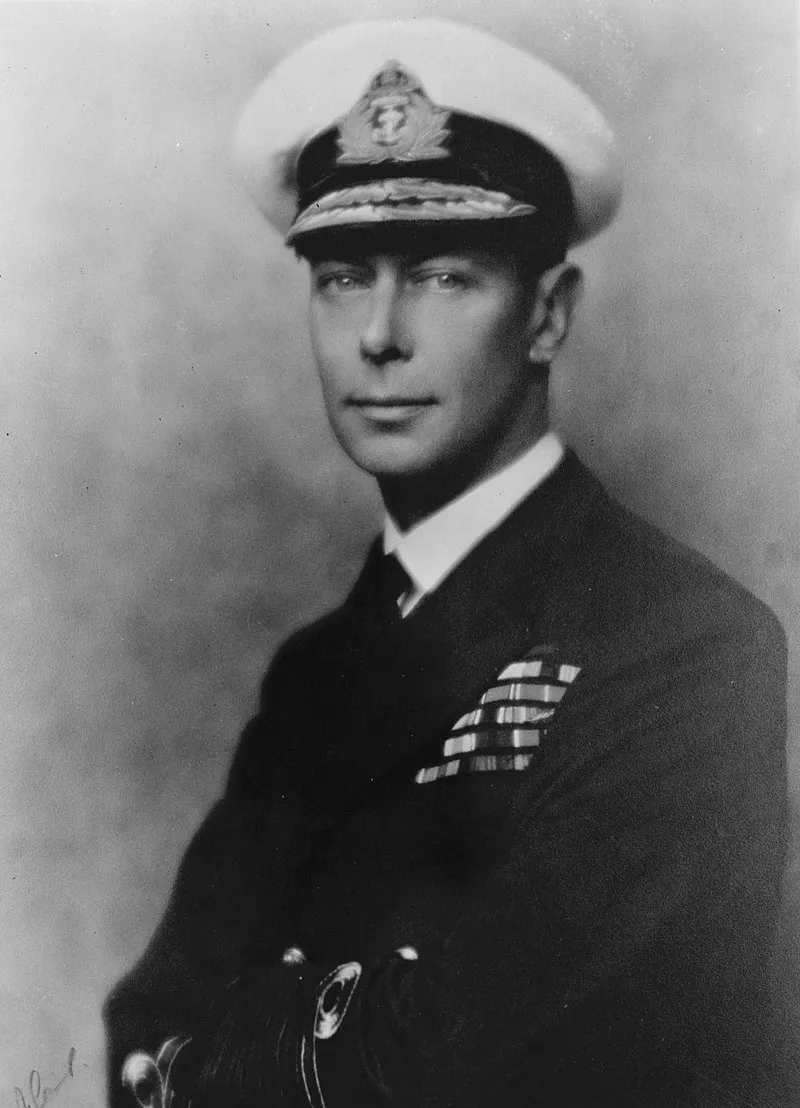
(British Government Photo)
King George VI (Albert Frederick Arthur George; 14 December 1895 – 6 February 1952), reigned from 11 December 1936 - 6 Feb 1952.

Cypher, King George VI (Albert Frederick Arthur George).
.webp)
.webp)
(Author Photos, 16 July 2025)



(Author Photos)
6-pounder 7-cwt Anti-Tank Gun Mk III, B/L No. L/16919, T, G-1966, weight 5-2-20 (636 lbs) mounted on an iron Mk. I carriage. This gun stands facing the Halifax Citadel.

(Library and Archives Canada Photo, MIKAN No. 3397506)
25-pounder C Mk. 2 QF Field Gun, 1st Field Regt RCHA on a field exercise, Barham, England, 10 April 1942.
.webp)
.webp)
(Author Photos)



(Author Photos)
25-pounder C Mk. 2 QF Field Gun with No. 9 circular firing platform, II/I, SIC.11.42 Canada, FL5647S1044, mounted on an iron carriage with a plate stamped Carr 25 pdr Mk. I, 1942, Reg. No. CA10606. This gun stands facing the Halifax Citadel.
.webp)
(Author Photo, 16 July 2025)




(Author Photos)
American 90-mm M1A1 Anti-Aircraft Gun, 2605, mounted on an iron carriage with plate stamped 90mm AA Recoil Mech M1A1, No. 8269. This gun stands facing the Halifax Citadel.
.webp)
.webp)
.webp)
.webp)
(Author Photos, 16 July 2025)





(Author Photos)
155-mm C1 (M1A2) Medium Howitzer on M1A2 Carriage, aka M114, manufactured at Sorel Industries Limited in Quebec, Queen Elizabeth II cypher. This Gun is located beside MARCOM HQ below the McDonald Bridge in the Halifax Dockyard. CFR 34404. The carriage plate reads: CARR. HOW. 155MM M1A2 CDN. SOREL INDUSTRIES LTD. CANADA 1955, REG. NO. CDN 14, INSP (symbol). This gun is currently located beside 3 Int Coy in Willow Park.

(Author Photo)
Second World War era Bailey Bridge pieces erected in honour of all Military Engineers who served in Fortress and Port Halifax since 1749.
.webp)
(Author Photo)
9th Canadian Siege Battery Memorial Plaque, Royal Artillery Park.

German First World War 7.92-mm Maxim Spandau MG 08/15 machine gun being examined by Canadian Motor Machine Gun Brigade Officers, March 1918. (Library and Archives Canada, MIKAN No. 3522120)

(Author Photo)
German First World War 7.92-mm Maxim Spandau MG 08/15 heavy machine gun (Serial Nr. 8411), Gwf Erfurt 1917, no data. This MG 08/15 was likely captured ca 1918 by a Battalion of a Brigade within a Canadian Division of the Canadian Expeditionary Force (CEF) in France. This weapon is on display inside the Officers Mess at Royal Artillery Park.
.webp)
.webp)
.webp)
.webp)
.webp)
.webp)
(Author Photos, 16 July 2025)
French SBML 10-inch Mortar, (Serial No. 5338), captured at Fortress Louisbourg.
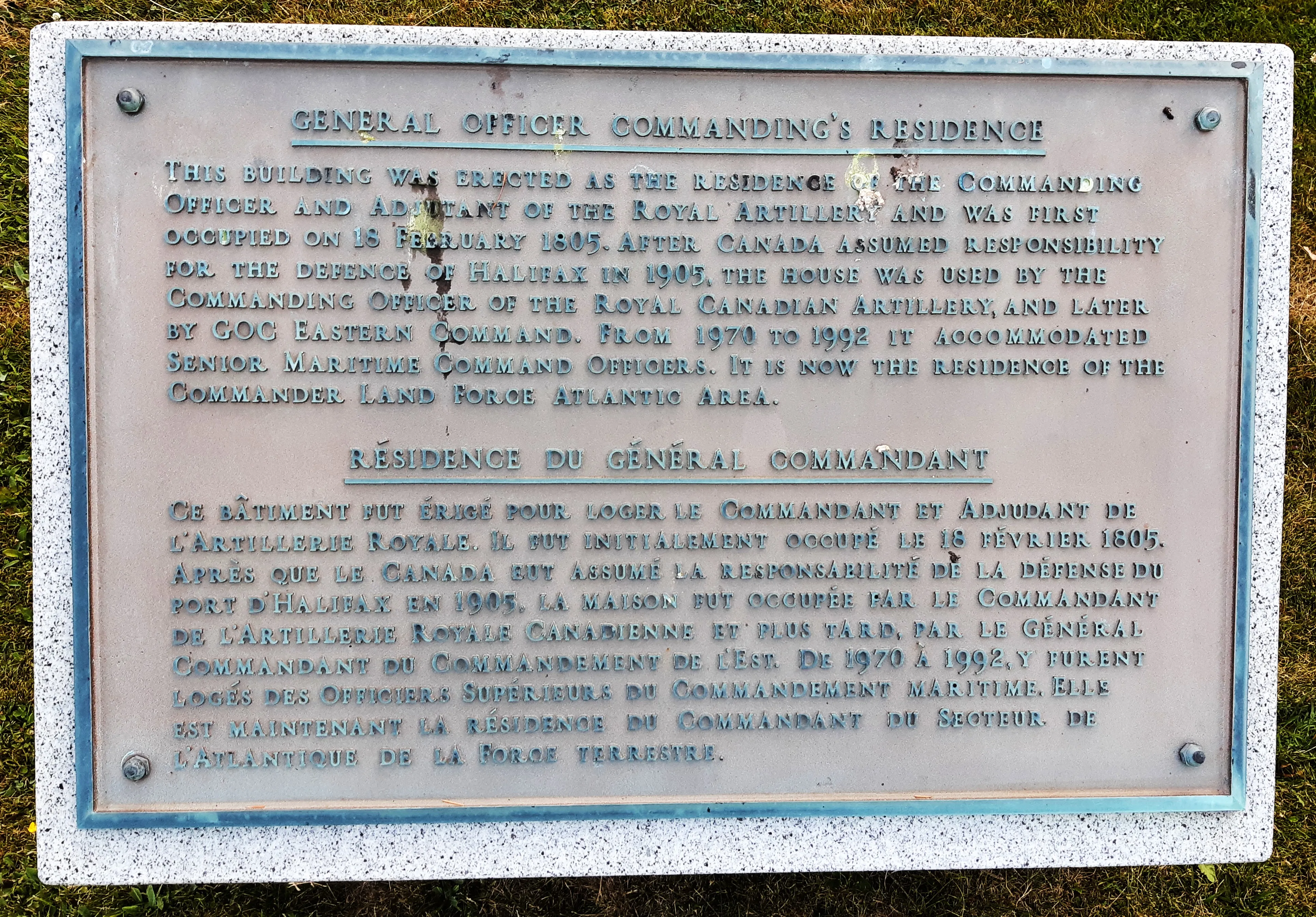
(Author Photo, 16 July 2025)
General Officer Commanding's Residence plaque.

I would imagine that many of you who are reading this book are very likely familiar with the standard routine of military training exercises and the rigours of being in the field in all seasons, not to mention the conditions found on deployment these days. Whether or not you have experienced it, I am sure you can well imagine what it is like to train and work in the heat, the dust and the mosquitoes in summer, the wind, the rain and the mud in the spring and fall, the snow and the cold in the winter and of course the routine day-to-day challenges of combat exercises in the training areas of the Canadian Forces. For most in the Army, this includes CFB Gagetown, CFB Valcartier, CFB Petawawa, CFB Kingston, CFB Shilo, CFB Edmonton, CFB Wainwright, CFB Suffield and all the fields and exercise areas of LFAATC Aldershot and LFCATC Meaford and their environs.
As an Army Officer in the Canadian Forces, it has been my privilege to have served alongside a tremendous number of highly professional military men and women of our nation while taking part in training in Germany, the UK and the USA and while on operational deployments to Cyprus, Bosnia-Herzegovina and in Afghanistan. During my training and military professional development, I have learned much about our long military history. My interest in our multi-faceted historical record has led me to write about it and to seek out the stories about Canada's military servicemen and women and the tools and equipment they used to preserve our security when warclouds darkened our horizons.
As a military history enthusiast, I have learned over the years that there are many with similar interests in preserving our story. We have all seen the odd old gun or retired tank placed on display outside a Militia Drill Hall, War Memorial, city park site or Royal Canadian Legion Hall, and many will have enjoyed visiting a number of our military Museums. The vast majority of retired wartime combat equipment used by members of the CF have dwindled in number, many being scrapped, others being shot up as targets, while a few have been sold to overseas operators and collectors. Fortunately, a handful of important examples of retired CF guns and war machines have been preserved and may be found in a wide variety of locations throughout Canada.
Curators, docents and volunteers working in Canada's military museums have been successful in preserving a good number of retired military weapons of war and many are still being sought after and in some cases, being restored to running condition again. As an artist, photographer and military history enthusiast, I have attempted to keep track of where historic Canadian military equipment has survived and is presently located and to make that information available to others with the same interest. For those of like mind, the purpose of this handbook is to provide a simple checklist of the classic Great War and WWII artillery that is part of our military heritage and a location guide to where they can be found in Canada. The book includes a number of photographs to illustrate an example of each gun wherever possible, and lists the locations of the survivors by province.
The numbers of restored Canadian guns is actually increasing as a few rare examples are being recovered from scrapyards and monument sites and salvaged for restoration. (Ultra rare items such as Skink AA gun turrets come to mind). One of the aims of this book is to help an enthusiast track down these monuments and museum artefacts and to have a simple reference book on hand with more detailed information about them such as a serial number, a Museum location and contact information which might be helpful in learning a bit of the history of a particular vehicle. The guns detailed in this handbook are listed alphabetically by manufacturer, number and type in the order that they came into service with the CF. The data is also appended with a list of most of the current guns found in the various collections and Museums in Canada. The book is also meant to serve as a companion volume to "Ironsides", Canadian Tanks and Armoured Fighting Vehicle Museums and Monuments, also available online.
It is my sincere hope that more of the guns and artillery found in this list will one day be added to the record of historically important military armament survivors that have been recovered and restored.
Shelldrake can be ordered online in softcover or e-book at these bookstores:
http://bookstore.iuniverse.com/Products/SKU-000542288/Shelldrake.aspx
Photos and technical data on artillery preserved in Canada may be viewed by Province on separate pages on this website.

This third volume of Cannon in Canada is an informative and detailed synopsis of the carefully preserved and restored guns and artillery on display in the province of Nova Scotia. The Royal Regiment of Canadian Artillery is represented by a long and distinguished line of gunners with historical ties back to the days before Canada’s Confederation. The honour of defending Canada while standing ready to support operations overseas in peace and war continues to this day. It is necessary to remember that the weapons of war are an integral part of what keeps this nation safe. The descriptions of artillery found here, and the places of honour where they can be viewed in Nova Scotia highlights the importance of this essential military hardware that brought our nation forward at key turning points in history when our guns were in use as tools of war at home and overseas.
You can order a copy of this book on line here:
https://www.amazon.ca/Cannon-Canada-Province-Nova-Scotia-ebook/dp/B08X18G4NP/ref=sr_1_1?dchild=1&keywords=harold+skaarup+nova+scotia&qid=1623449248&sr=8-1
https://www.barnesandnoble.com/w/cannon-in-canada-province-by-province-volume-3-harold-skaarup/1138863787?ean=9781953584977





